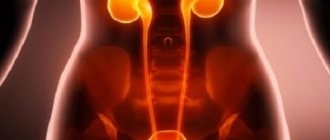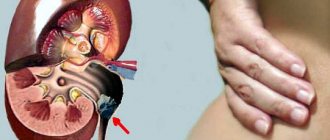25.01.2017
In a healthy person, fungus is not normally found in the urine. In some cases, molds, yeasts, and rays can be found in the urine. This is facilitated by certain factors - improper use of antibiotics, immunodeficiency (primary and secondary), urinary tract infections (pyelonephritis, urethritis, cystitis).
Yeast is often found in the urine (Candida). If the result of two urine tests shows the presence of Candida fungi in large quantities, doctors talk about candiduria.
If Candida fungi actively multiply in a woman’s vagina, they can ascend through the urinary ducts into the bladder. Typically, asymptomatic candiduria is not accompanied by clinical signs and is discovered randomly. In this case, treatment is not prescribed. But if candiduria is detected against the background of diabetes mellitus, immunodeficiency, old age, tuberculosis of the urinary system, it is necessary to undergo examination and take action.
Symptoms of candidal cystitis
Candidiasis is a type of fungal infection caused by the growth in the human body of a yeast-like fungus of the genus Candida. Most often, the disease affects the genital and urological areas and occurs in the male and female population. The following types of disease are possible in the male body:
- epididymitis - infection affects the testicles;
- candidal urethritis - the lesion is located in the urinary tract;
- balanoposthitis – the disease forms on the foreskin of the penis;
- candidal prostatitis - a fungus develops in the prostate gland.
The danger of the disease lies in its tendency to relapse. Infection of the prostate with Candida fungus is not widespread, and this often makes timely detection of the disease difficult. This situation leads to the development of a chronic form.
- Often the development of a fungal infection in the bladder occurs asymptomatically. Negative consequences with this type of carriage of microorganisms are usually not detected, but if immunity is reduced, the infection can spread throughout the body;
- With candidal cystitis, an alarming signal of an acute pathological process is frequent painful urination and a feeling of incomplete emptying of the urinary organ. Cloudy urine is released in small portions. It may have an unpleasant sour smell;
- In the acute period, the patient suffers from fever, headaches, and weakness.
- Due to painful frequent urge to empty the bladder, the patient becomes irritable;
- Candiduria develops - fungi of the genus Candida are detected in large quantities in the urine;
- Final hematuria is noted - the presence of blood in the last portion of biological fluid that is produced by the kidneys;
- Heaviness and pubic pain appear in the lower abdomen;
- Constant burning and itching dramatically reduce a person’s quality of life;
- Acute candidal cystitis can become chronic;
- These symptoms are often accompanied by candidal colpitis - inflammation of the vagina.
Symptoms and signs
Most patients with candiduria are asymptomatic. It remains unclear whether the presence of Candida can cause urethral symptoms (mild itching, dysuria, watery discharge) in men. In rare cases, dysuria in women occurs due to candidal urethritis, but it can also be caused by contact of urine with periurethral tissues inflamed due to candidal vaginitis.
Among lower urinary tract infections, cystitis due to Candida can lead to pollakiuria, urgency, dysuria, and pain in the suprapubic region. Hematuria is often observed and in patients with poorly controlled diabetes, pneumaturia due to the development of emphysematous cystitis. Fungal masses and bezoars can cause symptoms of bladder outlet obstruction.
With renal candidiasis of hematogenous origin, most patients have no local symptoms, but antibiotic-resistant fever, candiduria, and unexplained deterioration in renal function may occur. Elements of fungal masses in the ureter and renal pelvis often cause hematuria and obstruction of the renal tract. Sometimes necrotizing papillitis, intra- and perinephric abscesses cause pain, fever, hypertension and hematuria. Patients may experience manifestations of candidal infection in other locations (for example, central nervous system, skin, eyes, liver, spleen).
Etiology of the disease
Fungal microorganisms are common etiologic agents of bladder infections. They are most often caused by toxic yeast-like fungi of the genus Candida. The bladder cannot be affected by candidiasis in isolation.
- Urogenital candidiasis is a very rare independent disease. In almost all cases, the patient is found to have fungal infection in other organs - the reproductive system, intestines;
- The urinary system is protected by nature from the harmful penetration of infection into the bladder from below, from the urethra - the urethra. For this reason, ascending infection rarely causes candidal cystitis;
- This pathology especially often affects women with anatomical features. Their urethra is straighter, wider and shorter than that of men. Candida directly penetrates the bladder cavity;
- Most often, the penetration of hospital infections is facilitated by the use of diagnostic and therapeutic instrumental methods: bladder catheterization procedures, X-ray, endoscopic examinations of this organ, since fungal microorganisms easily penetrate the urine collection system and other instruments;
- A fungal infection penetrates the bladder and causes inflammation if the immune defense is significantly reduced. A significant decrease in immunity is observed in patients with diabetes, AIDS, cancer patients after chemotherapy, and the elderly. Fungi in the body of a person with a weakened immune system can be deadly;
- The development of candidal cystitis is facilitated by the presence of intestinal candidiasis. This is usually a consequence of long-term use of antibacterial drugs that affect the microflora of our body. They destroy not only pathogenic bacteria, but also beneficial saprophyte bacteria that live in our body and form protection, preventing fungi from multiplying. Suppression of beneficial flora by antibiotics leads to colonization of not only the intestines, but also the urinary tract by Candida fungi;
- Often these pathological microorganisms end up in the bladder as a result of poor treatment of the genitals, insufficient urine outflow, the installation of intravenous catheters, and the use of drugs to artificially suppress the immune system.
DETAILS: Urology operation tour consequences and reviews
Diagnosis of fungus in urine
If a patient is suspected of having candiduria, an additional urine test must be prescribed in compliance with all collection rules. The analysis will show the number of leukocytes and candidal casts in the urine. If the presence of the latter is established, then there is an infectious process. If before the test the patient did not undergo any urological interventions or a catheter, then the causes of candiduria may be the following: diabetes mellitus, kidney disease, anomalies in the development of the urinary system. To clarify the cause, an ultrasound of the kidneys, a biochemical blood test, and urography are prescribed.
Basically, in a previously healthy person, candiduria goes away on its own, and subsequently yeast (Candida fungi) are not detected in the urine. The doctor’s task is to detect the possible source of the fungus.
How to recognize the disease
It is quite difficult to detect fungal prostatitis in the initial stage. The infection is often painless for humans. As the disease progresses and develops, certain symptoms may appear:
- disorder in the urinary system, pain when emptying the bladder;
- discomfort in the pelvic area;
- frequent urge to urinate, incontinence;
- itching in the penis area;
- specific plaque on the head of the penis;
- possible redness of the skin of the genitals, whitish clots on the head of the penis.
If primary signs of the disease are detected, you should immediately contact a specialist to avoid complications. A fungal infection in the process of growth can affect not only the genitourinary system, but also the entire human body. An advanced form of the disease can lead to bronchitis, laryngitis, rhinitis, pneumonia, and colitis.
Diagnosis of fungal urinary tract infection
Diagnosis is based on fungal culture, usually from urine. The threshold at which the degree of candiduria reflects a true candidal UTI, rather than just colonization or contamination, is unknown. Cystitis is usually diagnosed in high-risk patients with candiduria by the presence of signs of inflammation and irritation. Cystoscopy and ultrasound of the kidneys and bladder can help identify bezoars and obstruction.
Fever, candiduria and sometimes the passage of balls of fungal mycelium suggest ascending renal candidiasis. Although renal function is often impaired, severe renal failure rarely occurs without infrarenal obstruction. Additional imaging techniques can help assess the extent of urinary tract involvement. Blood cultures for Candda are usually negative.
Unexplained candiduria should prompt evaluation of structural pathology of the urinary tract.
Factors influencing the development of the disease
Every person's body contains a fungus of the genus Candida. When the immune system is fully functioning, this factor does not pose a danger. Experts identify several main reasons that affect the decrease in immunity, which causes fungal prostatitis:
- viral colds that occur on a regular basis;
- sedentary lifestyle, sedentary work;
- frequent nervous tension, stress, irritability, overwork;
- metabolic disorders caused by poor diet;
- long-term (regular) hypothermia of the pelvic organs;
- sexual contact with an infected partner;
- chronic forms of diseases of the genitourinary system;
- lack of regular sex life.
In addition to common risk factors, there are many other reasons that influence the development of infection. Congenital or acquired as a result of injury, narrowing of the urethra leads to low urine outflow, provoking the development of a bacterial background.
Any form of trauma to the groin area or pelvic organs can interfere with proper blood circulation, causing stagnation processes; much less often, the appearance and development of the disease can be preceded by a hereditary predisposition.
Causes of development of candidiasis of the bladder and kidneys
The following factors can provoke the development of a pathological process:
- decreased general or local immunity;
- intestinal dysbiosis;
- long-term use of medications;
- presence of chronic diseases;
- fungal infection of other internal organs;
- unprotected sexual intercourse with an infected partner;
- pathologies of metabolic processes;
- malignant neoplasms;
- hormonal disorders;
- HIV and AIDS;
- overweight;
- prematurely completed treatment of sexually transmitted diseases;
- frequent medical procedures;
- congenital malformations of the parathyroid glands;
- alcohol abuse or drug use.
Treatment of the disease
- Asymptomatic candidal cystitis and candiduria, which do not manifest themselves in any way, usually do not require treatment if immunity is normal;
- The patient definitely needs to see a doctor so that he can find out the causes of the malfunction in the body, help establish balance and strengthen the immune system;
- It is necessary to eliminate the factors that led to the development of the disease;
- Treatment of candidal cystitis with antifungal drugs is prescribed. Fluconazole and Fucis are effective for uncomplicated disease. Amphotericin stops the proliferation of fungi against the background of immune disorders. The problem of eliminating the consequences of exposure to candidiasis is being solved;
- Traditional medicine is used as prescribed by the doctor: rose hips, lingonberry leaves, cornflower flowers, St. John's wort, bear's ears.
DETAILS: Operations for urological diseases
Bladder candidiasis can be treated only under the supervision of a doctor. Because if the course of treatment turns out to be insufficiently strong or incorrect, the disease can affect the organs of the reproductive system and develop into dysbacteriosis. Infections that accompany the development of this pathology are dangerous. Only a doctor can decide which fungi caused the development of the pathological process and prescribe medications depending on the characteristics and course of the disease.
Features of the treatment of thrush in the bladder
For candidiasis of the bladder, treatment is carried out for any form, including asymptomatic.
It is carried out on an outpatient basis, but in severe cases, doctors recommend inpatient therapy.
The main activity is specific antimycotic therapy. For this purpose, drugs that can act on fungi of the genus Candida are used:
These drugs inhibit the growth and reproduction of fungi. Diflucan and Fluconazole are prescribed orally for the treatment of bladder candidiasis; Orungamine and Itraconazole are also available in injection forms. The course of treatment is 14-21 days. The drugs may cause the following side effects:
- headache and dizziness;
- dyspeptic symptoms;
- allergic reactions.
They are not recommended for use in pregnant women with individual intolerance.
Severe candidiasis is treated by rinsing the bladder with a solution of amphotericin B. This is a strong antifungal drug and has a pronounced toxic effect. Refers to polyene antibiotics. Helps destroy fungal cells. The dosage of drugs and their combinations is determined by the doctor, taking into account the severity of the pathological process and the characteristics of the body. Treatment with Amphotericin may cause nausea and vomiting, headache, and severe anemia.
The drugs are approved for use even in newborns. Dosages are calculated based on body weight. Cautious use is recommended in the presence of liver and kidney diseases. It is not advisable to use these medications in pregnant women. The end of treatment is carried out after a negative urine culture for fungal flora.
Infusion therapy is used to desensitize and detoxify the body:
- sodium chloride solution;
- polyglucin;
- sodium thiosulfate.
In addition to specific treatment, symptomatic therapy should be prescribed:
- antispasmodics – No-shpa, Platyfillin;
- anti-inflammatory - Nimesil, Movalis;
- diuretics – Veroshpiron, Diuver;
- hemostatics – Vikasol, Etamzilat.
In addition to drug therapy, bladder lavage and antiseptic instillation are used. After a course of antifungal drugs, it is necessary to take immunostimulating agents. To strengthen the immune system and prevent relapses of the disease, Cycloferon, Viferon, Polyoxidonium are prescribed according to the scheme.
It is recommended to follow a therapeutic diet. The following foods are excluded from the diet:
- fatty and fried foods;
- smoked meats and preservatives;
- spices;
- alcohol;
- cheese;
- products made from yeast dough.
It is recommended to limit carbohydrates, meat products, and salt. A dairy-vegetable diet, a large amount of vegetables and fruits, and herbs is preferable.
During the treatment period, it is necessary to limit physical activity and maintain bed rest in the presence of fever. It is not recommended to take a bath - use a shower instead, after which the genital area is thoroughly dried.
Alternative treatment is used only under the supervision of a doctor. It is not always effective, and if used incorrectly it can cause harm. Home remedies cannot be used as primary therapy, they can only be auxiliary. Medicinal plants that have a diuretic and anti-inflammatory effect are used.
- Infusion or decoction of bearberry. Take a glass twice a day.
- Herbal collection Brusniver. Drink a glass before bed.
- For washing, use a decoction of chamomile or calendula flowers, or an infusion of oak bark.
Stages of diagnosis and treatment
To confirm the presence of fungal prostatitis, several stages of careful diagnosis are required.
Only after a complete examination and collection of the results of all the main stages of diagnosis can the attending physician prescribe treatment. The process of getting rid of the disease is long and painstaking, requiring strict adherence to the specialist’s instructions.
The urologist draws up a treatment regimen that will help reduce the active growth of the disease and prevent further inflammation. A full course of combating the disease includes taking drugs that have an antimycotic effect. These include fluconazole, itraconazole, ketaconazole, amphotericin and others.
The drugs used in treatment have a high degree of toxicity, so you should carefully follow the dosage prescribed by a specialist.
Complex treatment
Fungal prostatitis is treated not only with medication. The key to successful recovery is complex therapy. Antifungal agents disrupt the natural microflora of the human body, therefore it is important to take restorative drugs, B vitamins, and microelements.
Particular attention should be paid to proper nutrition and daily routine. The menu should include vegetables, fruits, and natural products. It is advisable to remove fatty, spicy, sour, and salty foods from the diet. Drinking alcoholic beverages and coffee has a negative effect on treatment.
In addition to drug treatment, physical therapy with a set of special exercises will help speed up the recovery process. Physiotherapeutic procedures are effective in combating fungal disease. These include electrophoresis, ultrasound therapy, therapeutic massage and electrical stimulation of the prostate gland. In some cases, the doctor prescribes mud baths that help restore men's health.
DETAILS: Local treatment in urology
Treatment of fungal diseases in men
Fungal diseases of the genitourinary system in men at the initial stage of development are treated on an outpatient basis with the help of effective medications and alternative medicine recipes.
However, if the disease has reached an advanced stage, experts recommend inpatient therapy.
The basis of therapy is the use of antifungal drugs that quickly destroy pathogenic microorganisms and eliminate the symptomatic manifestations of candidiasis. The most effective means intended to combat fungal infection are:
- Fluconazole is a popular synthetic drug that is highly active in inhibiting the growth and reproduction of fungi. The medication has a large list of contraindications for use, which you must familiarize yourself with before starting treatment.
- Amphotericin B is a fungicidal drug in the form of a concentrate for the preparation of a solution for infusion. The product quickly copes with fungal infection and reduces the severity of symptoms after just a few days of regular use.
- Itraconazole is a synthetic broad-spectrum antifungal agent in tablet form that suppresses the synthesis of ergosterol in the cell membrane of fungi. The medication suppresses the activity of pathogenic microorganisms and prevents re-infection.
In the process of treating a fungal disease, you should follow a special diet to speed up recovery. You need to follow a few simple rules:
- Limit the consumption of carbohydrates, sweets, potatoes, fatty, spicy and fried foods.
- Eat more fresh vegetables, herbs and fruits, lean meat. Replace sweets with dried fruits.
- Avoid sugary carbonated drinks, alcohol, strong tea and coffee, and drink at least 1.5 liters of clean water per day.
You can enhance the effect of medications using proven folk remedies that are easy to prepare at home.
Showed good results in the treatment of candidiasis:
- chamomile and calendula decoction for washing;
- nut tincture for treating affected areas;
- mint tea with honey for oral administration.
Prevention measures
Treatment of fungal prostatitis is long and complex, therefore, after getting rid of candidiasis, preventive measures should be used. There are several simple rules, following which you can forget about an unpleasant illness forever:
- Proper diet with a large content of natural products. Mandatory consumption of onions, garlic, grapefruit, propolis, which will suppress the activity of fungal infections.
- It is important to pay attention to underwear; only cotton fabrics should be used.
- Avoid using enemas and douching. Such procedures help flush out beneficial microflora from the body.
- Safe and regular sex. A condom will help prevent infection if you have sex with an infected partner. A full sex life provides a natural massage to the prostate gland, preventing the development of the disease.
- Periodic examination by a urologist. Regular visits to a specialist will help identify the presence of the disease at an early stage.
It is important to listen to the signals of your own body, because any disease is easier to cure in the initial stage.
Sources: medicalnewstoday.com, ncbi.nlm.nih.gov, health.harvard.edu.
How to prevent infection?
To prevent infection or prevent the problem from recurring, it is recommended:
- Strictly observe the rules of personal hygiene, wash yourself twice a day and change your underwear regularly.
- Promptly treat any diseases of the genital organs and other systems under the supervision of a doctor.
- To stimulate the immune system and strengthen the muscle membrane, engage in physical exercise.
- Try not to overwork, observe a work-rest schedule, and sleep at least 8 hours a day.
- Take medications only as prescribed by your doctor.
- Eliminate the possibility of overheating or hypothermia of the genital organs.
- Lead a healthy lifestyle by giving up drinking alcohol and smoking.
- Have a medical examination with a gynecologist or urologist twice a year.
Fungal infection of the bladder is a pathology that requires long-term drug therapy, because it is impossible to get rid of the disease without the use of drugs.
During the course of treatment, it is necessary to strictly adhere to the doctor’s instructions without self-medicating, because the lack of special knowledge in the treatment of candidiasis can lead to a deterioration in well-being and the transition of the disease to an advanced stage.
Thrush as one of the causes of pyelonephritis
Thrush (vaginal candidiasis) is a disease caused by a fungus of the genus Candida due to a weakened immune system. This opportunistic symbiont inhabits the human body in the first days of life. In a healthy person, it is part of the healthy microflora, without manifesting itself in any way. The emergence of favorable conditions caused by:
- taking antibiotics;
- hormonal changes in the body that are associated with pregnancy, menopause, and the menstrual cycle;
- the wrong way of eating, where a large role is given to sweet, rich simple carbohydrates foods;
- endocrine disorders, including diabetes.
Antibiotics destroy beneficial microflora.
Itching, burning, cheesy discharge on the genitals, the appearance of erosive ulcers - this is how thrush manifests itself in men and women. It is women, due to the peculiarities of their anatomical structure, who more often suffer from complications in the form of cystitis. Penetration of the fungus through the urethra into the bladder and further into the kidneys is one of the causes of pyelonephritis.
Symptoms of pathology
The clinical picture of pyelonephritis will differ depending on the form of the disease - acute or chronic:
Symptoms of pyelonephritis
| Course of the disease | Acute | Chronic |
| Body temperature | Very high, up to 40 °C | Sudden increase to 38 ºС. |
| Accompanied by intense chills. | ||
| Pain syndrome | Aching character | Localized in the lumbar region |
| If the urinary tract is disrupted, it spreads to the perineum and external genitalia. | May become stronger with exercise. | |
| Urination | Becomes faster | Intensifies at night |
| Hurts | ||
| Arterial pressure | A sharp drop in diastolic pressure below 60 mmHg. Art. | Arterial hypertension is characteristic. |
Signs of diseases of the female genitourinary system
Drinking plenty of fluids and eating right is the key to the health of the whole body.
Diet is also disease prevention. It is important to exclude foods that contain purines and oxalic acid. Also limit your salt intake. Make it a habit to drink water on an empty stomach in the morning; only after this small procedure can you eat.
Eat small meals 5-6 times a day. Usually, for diseases of the genitourinary system, diets No. 6 and 7 are used. The main objectives of diet No. 6 are to reduce the amount of uric acid and salts formed in the body.
You need to consume more liquid, vegetables and fruits, as well as dairy products. And diet No. 7 is aimed at removing metabolic products from the body, combating swelling and unstable blood pressure. Here, on the contrary, liquid intake is limited, and cereals and salts, mainly plant foods, are excluded.
Types of diseases
What complications arise
A disease caused by a fungal infection leads to the following consequences:
- Inflammation of the kidneys - pyelonephritis.
- Due to an excessive number of harmful microorganisms, the patient develops signs of bacterial cystitis.
- Glomerulonephritis is an inflammation of the kidneys, leading to pathological changes in their tissues. The cause of this process is considered to be autoimmune disorders.
- Acute renal failure.
- Generalization of fungal infection (spread throughout the body).
It is difficult to get rid of such complications, so treatment should be started as early as possible.
What is pyelonephritis?
The inflammatory process, which predominantly affects the tubular systems of the kidneys, is called pyelonephritis.
Inflammation manifests itself in that at the site of damage to organ tissue, blood circulation changes, tissue degeneration and intensive cell division occur. The inflammatory complication of pyelonephritis is triggered by pathogenic microorganisms: staphylococci, E. coli, fungi, salmonella, chlamydia, proteus. Pyelonephritis is classified as follows:
- type:
- primary (not complicated),
- secondary (with damage to the kidneys and urinary tract);
- by lesion:
- unilateral,
- double-sided;
- according to the nature of the disease:
- spicy,
- chronic,
- recurrent;
- along the path of infection spread:
- hematogenous (infection spread through the bloodstream),
- urinogenic (the infection has passed up the urinary canal).
It is necessary to treat pyelonephritis under the supervision of a physician; hospitalization is indicated. Ignoring treatment leads to serious problems with kidney function. The most common: renal failure and arterial hypertension, anuria, pyonephrosis. The most dangerous complication is sepsis (blood poisoning).
What applies to the organs of the genitourinary system in women?
The genitourinary system is a complex of interconnected internal human organs responsible for the urinary and reproductive systems.
The female urinary system includes organs:
- two kidneys located in the abdominal region. A paired organ that serves the purpose of maintaining chemical balance in the body. Cleanses it of toxins and harmful substances. On the kidneys there are pelvises - places where urine accumulates, which systematically enters the ureter;
- ureters. Paired tubes that carry urine from the kidneys to the bladder;
- bladder. Organ that collects urine fluid;
- urethra. An organ that facilitates the release of urinary fluid from the body to the outside.
The female reproductive system includes external and internal organs. External ones include:
- labia large. They are fatty folds of the skin that protect the organ from external influences;
- labia minora. Folds of skin that are located under the large lips. Between the small and large sponges there is a genital gap;
- clitoris. It is the organ responsible for sensitivity and has the main function of the erogenous zone. Surrounded by the labia minora and located under the superior junction of the labia majora;
- entrance to the vagina. This is a small opening located in front of the lower junction of the labia majora. Protected by the hymen, the Bartholin glands are located between it and the inner lips, which serve to provide lubrication during sexual intercourse.
The internal female genital organs include:
- ovaries. The organ has the appearance of two oval bodies, which are connected to the body of the uterus from its posterior wall. The ovaries produce a hormone important for reproduction, as well as for the entire female body, estrogen;
- uterus. The piriform muscle body is located in the pelvic area. Designed for carrying a fetus, as well as for its rejection at birth. In the uterine canal, which passes into the vagina, mucus is concentrated, it helps protect the organ;
- fallopian (uterine) tubes. They pass from the corners of the uterine fundus to the ovaries, promoting the advancement of the mature follicle into the uterine cavity;
- vagina. A muscular tube-like organ extending from the cervix to the genital slit. Covered from the inside with a mucous membrane, which provides protection against pathogenic organisms through the secretion of lactic acid.
The condition of a woman’s urinary system is monitored by a nephrologist, and the reproductive system by a gynecologist.
Infections of the genitourinary system in women are pathological effects caused by specific harmful microorganisms. Urinary tract diseases are characterized by inflammation, which is easy to cure in the initial stage or, if the signs are ignored, becomes chronic.
In the female body, the organs of the urinary system function in close connection with the internal genital organs. Therefore, there is such a thing as the genitourinary system, infections of which affect both the reproductive system and the urinary tract.
The organs of the female genitourinary system include:
- bladder;
- kidneys;
- ureters;
- uterus;
- ovaries;
- fallopian tubes.
Types of diseases
As a rule, infections enter the female body through sexual contact and are caused by various viruses, fungi or parasites.
Infectious diseases of the female genitourinary system include:
- Cystitis;
- Pyelonephritis;
- Urethritis;
- Glomerulonephritis;
- Mycoplasmosis;
- Ureaplasmosis;
- Thrush;
- Herpes;
- Chlamydia;
- Syphilis;
- Gonorrhea;
- Trichomonia;
- Papillomavirus;
- Hepatitis.
The main symptoms that occur with almost any infectious disease that is transmitted sexually include the following:
- problems with urination, false urges may occur or, conversely, the need to visit the toilet too often;
- painful sensations when urinating, pain, burning or itching;
- swelling;
- dizziness;
- pain in the lumbar region, sharp or dull, depending on the nature of the disease;
- weakness, sleep disturbances, headaches;
- temperature increase;
- uncharacteristic vaginal discharge;
- blood in the urine;
- various rashes on the external genitalia.
Due to the specific anatomical structure of the body, diseases in the genitourinary system occur much more often in women than in men.
Women must pay attention to the signals of their own body, even if they are insignificant. For example, with infections of the genitourinary system, there is often discomfort during sexual intercourse, pain, and in some cases there is frigidity or a complete absence of orgasm.
Cystitis
A disease characterized by inflammation of the bladder is cystitis. The most common cause of this disease is E. coli, which is usually found in the rectum, but enters the urinary system due to the fact that the urethra in women is located very close to the anus.
Cystitis often results from unprotected sexual intercourse if the sexual partner is a carrier of a bacterial infection.
Main symptoms of cystitis:
- burning when urinating;
- impurities in urine;
- pain in the lower back and general deterioration in health.
Cystitis is usually treated with medications, as well as traditional medicine methods.
Pyelonephritis
Inflammation in the kidneys is pyelonephritis, which also occurs due to a bacterial infection that enters the female genitourinary system. Pyelonephritis usually develops against the background of some other disease, and methods of its treatment depend on the cause.
The nature and severity of symptoms of pyelonephritis usually vary depending on the form of the disease and the type of bacterial infection. But the main signs of this disease are:
- pain and heaviness in the lower back;
- stomach ache;
- frequent urination;
- in some cases, increased blood pressure levels;
- weakness and decreased performance;
- significant increase in temperature.
Pyelonephritis is characterized by acute stages, as well as stages of remission, in which all symptoms, as a rule, recede, with the exception of signs of hypertension and general poor health.
Antibiotics are used to treat pyelonephritis.
Glomerulonephritis
One of the severe and dangerous kidney diseases is glomerulonephritis, which occurs as a result of infection of the body with streptococci, characterized by the following symptoms:
- impurities of blood in the urine, staining of urine in a characteristic color;
- swelling and shortness of breath;
- increased blood pressure;
- weakness.
These signs are common, but in some cases there may be additional symptoms.
Urethritis
The inflammatory process in the urethra is called urethritis. This disease is quite widespread, and, despite the fact that it does not pose any serious threat to a woman’s life, it still requires timely treatment, since it causes severe discomfort.
Symptoms of urethritis:
- burning and itching during urination, as well as during menstrual bleeding;
- redness of the external genitalia, sometimes swelling occurs;
- discharge of pus along with urine.
Many people confuse urethritis with cystitis due to the similarity of symptoms of the diseases.
Mycoplasmosis
Urogenital mycoplasmosis often affects the female body due to a weakened immune system. As a rule, the disease occurs in the urethra, as well as in the vagina and cervix.
Mycoplasmosis is transmitted in most cases through sexual contact, in particular through unprotected sexual intercourse. With this disease, a combination of ailments such as vaginitis and urethritis is observed, and it manifests itself as follows:
- uncharacteristic mucous discharge from the vagina;
- itching and burning sensations of the external genitalia;
- pain during sex;
- pain in the lower abdomen and lumbar region.
Complications of mycoplasmosis often include illnesses such as pyelonephritis, adnexitis, and in especially severe cases, infertility can develop.
Ureaplasmosis
A common cause of ureaplasmosis is unprotected sexual intercourse with an infected partner. And this disease can be asymptomatic for a long time, and the first signs appear only under the influence of some factors.
Symptoms of ureaplasmosis:
- discharge from the genital tract with an unpleasant odor;
- cutting pain in the lower abdomen;
- discomfort when urinating;
- discomfort during sexual intercourse.
This disease requires proper and timely treatment of both sexual partners at once.
Thrush
Candidiasis or thrush is the most common condition among women. This disease usually appears against the background of some other lesions of the female genitourinary system and is characterized by such symptoms as severe burning and itching of the genitals, cheesy unpleasant discharge with a sour odor.
Chlamydia
Chlamydia, like many other infectious diseases of the genitourinary system, is a very insidious disease that can be asymptomatic. But if signs do arise, they include:
- pain in both internal and external genital organs;
- itching;
- purulent discharge with mucus and an unpleasant odor from the genital tract;
- weakness and elevated body temperature.
If such phenomena occur, a woman must visit a gynecologist and undergo the necessary tests, since the listed symptoms may indicate both the presence of chlamydia and the development of some other equally dangerous disease.
Syphilis
A classic disease of the genitourinary system, which is transmitted through sexual contact, is syphilis.
Symptoms of syphilis vary depending on the stage of the disease. Primary syphilis is characterized by enlarged lymph nodes and the appearance of ulcers on the external genitalia or on the cervix (chancroid).
Gonorrhea
Causes
The infection enters the kidney through the blood.
Any source of infection can cause pyelonephritis, regardless of its location and distance from the kidneys. Dental caries, at first glance, is not associated with the genitourinary system, but can become a source of infection. The so-called hematogenous method of infection implies that the infection from the source of the disease enters the blood and thus enters the kidney. The urinogenic method of infection includes inflammatory diseases of the genitourinary system. Infection through the urethra penetrates into the urinary canal, causing cystitis (in women) and urethritis (in men). If the treatment of these diseases was ineffective, the infection penetrates the kidneys, starting the inflammatory process.










